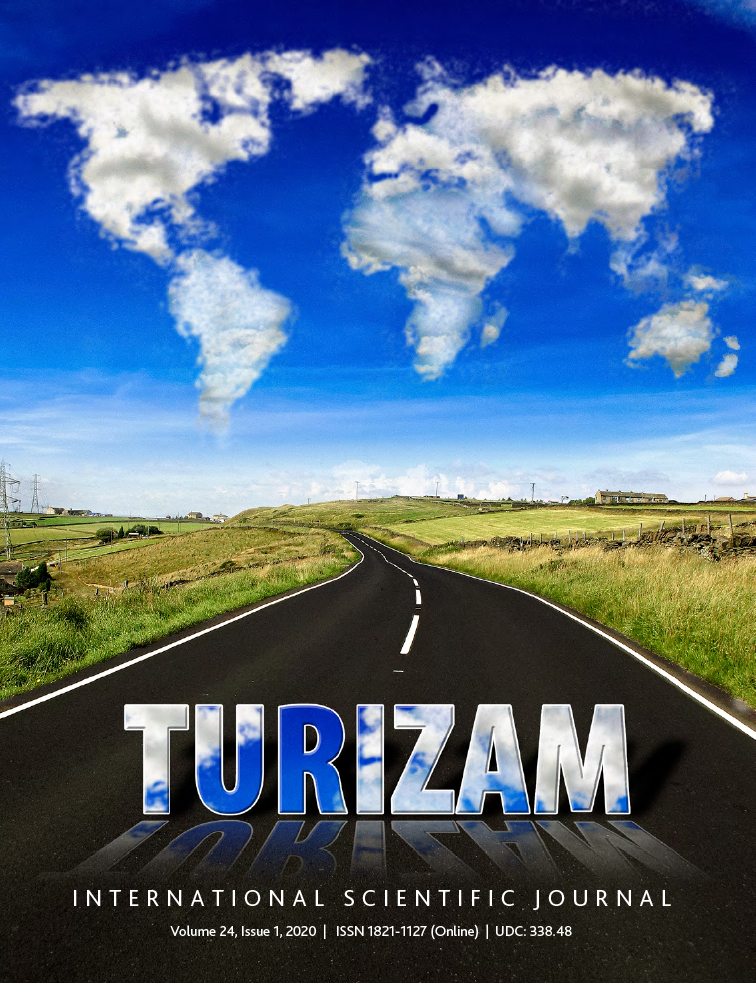REFLECTIONS OF DESTINATION QUALITY ON DESTINATION IMAGE: A CASE OF KUŞADASI
Abstract
The image of a tourism destination is assembled on various resources including past encounters and as well as on marketing communications. However, the utmost important factor in increasing tourist arrivals is creating a sustainable tourism and a high quality of service at a destination in general. The main purpose of this study is to ascertain what image the stakeholders have in their mind about Kuşadası through ineterviews and what image the the tourists have as exemplified in the 15,047 reviews about the destination in TripAdvisor through a content analysis. The importance of this study is that it sheds light on the role and impact of destination quality on tourists’ destination image.
References
Agapito, D., Valle, P., Mendes, J. 2013. The cognitive-affective-conative model of destination image: A confirmatory analysis. Journal of Travel & Tourism Marketing, 30(5), 471-481.
Baloglu, S., McCleary, K. W. 1999. A model of destination image formation. Annals of Tourism Research, 26 (4), 868-897.
Cooper, C., Fletcher, J., Gilbert, D., Shepherd, R., Wanhill, S. (eds). 1998. Tourism, Principles and Practices. 2nd ed, Addison Wesley Longman, England.
Dwyer L., Kim C. 2003. Destination competitiveness: Determinants and indicators. Current Issues in Tourism. 6 (5), 369-414.
Echtner, C.M., Ritchie, J. R. B. 1993. The measurement of destination image: An empirical assessment. Journal of Travel Research, 31 (4), 3-13.
Go Frank M., Govers Robert 2000. Integrated quality management for tourist destinations: A European perspective on achieving competitiveness. Tourism Management. 21, 79-88.
Govers R., Go Frank M., Kumar K. 2007b. Promoting Tourism Destination image. Journal of Travel Research, 46, 15-23.
Gretzel. U., Yuan Y., Fesenmaier D. R. 2000. Preparing for the new economy: “Advertising strategies and change in destination marketing organization”. Journal of Travel Research, 39 (2), 146-56.
Grönroos, C. 2007. Service management and marketing: customer management in service competition. John Wiley & Sons.
Gursoy, D., and McCleary, K. W. 2004. An integrative model of tourist’s information search behavior. Annals of Tourism Research, 31, 353-373.
Harris R., Howard J. 1996. Dictionary of Travel & Tourism Hospitality Terms. Melbourne, Hospitality Press.
Heath, E., Wall, G. 1991. Marketing tourism destinations: a strategic planning approach. John Wiley & Sons, Inc.
Hernandez-Mogollon, J. M., Folgado-Fernandez J. A., Duarte P. A. O. 2014. Event tourism analysis and state of the art. European Journal of Tourism, Hospitality and Recreation, 5 (2), 83- 102.
Kandampully, J., Mok, C., Sparks B. (Eds.) 2001. Service quality management in hospitality tourism and leisure, New York: Haworth Hospitality Press, p. 26.
Kim, H., Fesenmaier, D. R. 2008. Persuasive design of destination websites: An analysis of first impression. Journal of Travel Research, 47 (3), 3-13.
Kotler, P., Gertner, D. 2002. Country as brand, product and beyond. A place of marketing and brand perspective. Journal of Brand Management, 9(4–5): 249–261.
Kuo Y. F. 2003. A study on service quality of virtual community websites. Total Quality Management & Business Excellence, 13 (4), 461-473.
Meng, F. 2006. An examination of destination competitiveness from the tourists’ perspective: The relationship between quality of tourism experience and perceived destination competitiveness (Ph.D. dissertation). Virginia Polytechnic Institute and State University.
Murphy P., Pritchard, M., Smith, B. 2000. The destination Product and its impacts on travelers’ perceptions. Tourism Management, 21 (1), 43-52.
Onder, I., Marchiori, E. 2016. A comparison of pre-visit beliefs and projected visual images of destinations. Tourism Management Perspectives, 21, 42-53.
Ortigueira L. C., Gómez-Selemeneva, D. 2011. Critical success factors of a tourist destination in the Caribbean. Book of proceedings Vol. 1 – International Conference on Tourism & Management Studies – Algarve 2011
Ritchie, J. R. B., Crouch, G. I. 2003. The competitive destination, a sustainable tourism perspective. Cambridge: Cabi Publishing.
Standing, C., Tang-Taye, J-P., Boyer M. 2014. The Impact of the Internet in Travel & Tourism: A research review 2001-2010. Journal of Travel & Tourism Marketing, 31 (1), 82-113.
Tian-Cole S., Crompton J. L. 2003. A conceptual of the relationship between service quality and visitor satisfaction and their links to destination selection. Leisure Studies, 22, 65-80.
Tosun, C., Bekir B. D., Fyall, A. 2015. Destination service quality, affective image and revisit intention: The moderating role of past experience. Journal of Destination Marketing & Management, 4, 222-234.
Vatter, O. 2014. Communication in destination marketing case study: Tallinn European Capital of Culture 2011. Procedia-Social and Behavioral Sciences, 148, 170-176.
Wang, Y. 2011. Destination marketing and management: Scope, definition and structures. In Y. Y. Wang, & A. Pizam (Eds.), Destination marketing and management: Theories and applications (pp. 1-20). Wallingford, UK: CAB International.
Weiermair, K., Fuchs, M. 1999. Tourist and retailers perceptions of services. Annals of Tourism Research, 26, 1004-1021.
Woods M., Deegan J. 2003. A warm welcome for Destination quality brands: The examples of the pays Cathere region. International Journal of Tourism Research, 5, 269-282.
World Tourism Organization. 2007. A practical guide to tourism destination management.
Yuksel, A. 2004. Shopping experience evaluation: A case of domestic and International visitors. Tourism Management. 25, 751-759.
Yuksel, A., Akgul O. 2007. Postcards as affective image makers: An idle agent in destination marketing. Tourism Management, 28, 714-725.
Zainuddin Z., Radzi S. M., Zahari M. S. M. 2016. Perceived destination competitiveness of Langkawi Island, Malaysia. Procedia-Social and Behavioral Sciences 222, 390-397.
Zhang, H., Fu, X., Cai, L.A., Lu, L. 2014. Destination Image and Tourist Loyalty: A Meta-Analysis. Tourism Management, 40: 213-223.

